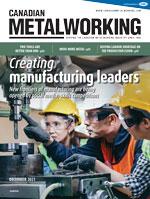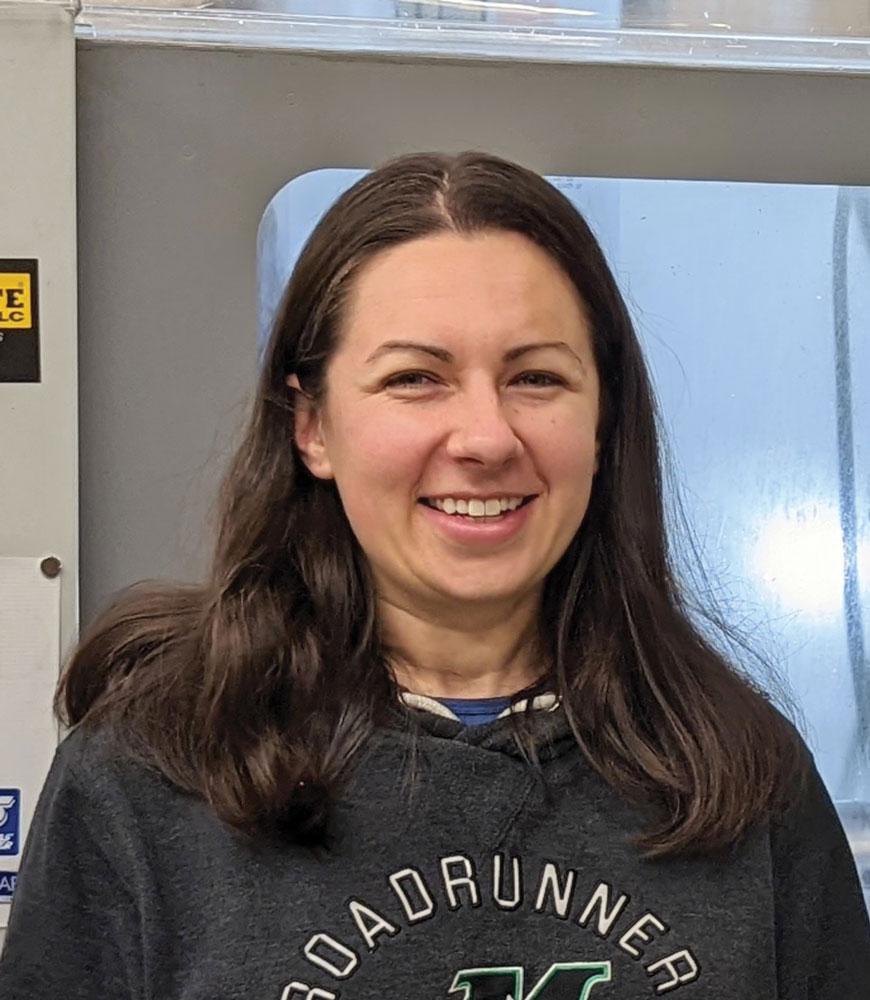Editor
- FMA
- The Fabricator
- FABTECH
- Canadian Metalworking
Creating manufacturing leaders
New frontiers of manufacturing are being opened by social media, skills competitions
- By Joe Thompson
- December 13, 2021
- Article
- Made In Canada

Canadian Metalworking introduces a few of the industry’s next generation of manufacturing leaders who will keep part production—and jobs—in Canada. WinnieVinzence/iStock/Getty Images Plus
Manufacturing is changing right before our eyes. And there isn’t a damn thing any of us can do about it.
While manufacturers have been regarded as slow to react to the changing business environment around them in the past, this time that luxury may not exist.
Automation, Big Data, cybersecurity, and evolving consumer trends will affect your business in every way, not just in sales, but in management, production, and even shipping.
With all challenges come opportunities. It’s up to today’s manufacturers to prepare for the new normal.
Advanced technology and data-driven tools will attract young workers who can help close the skills gap. These young workers then can be upskilled to create tomorrow’s manufacturing leaders.
Manufacturing still is very much alive in Canada, where the standard of living is high, where workers are highly skilled, and where the quality of manufactured goods is remarkable. In short, Made in Canada means something.
To keep this level of excellence, however, we need more skilled and semi-skilled workers for our manufacturing facilities. There is a shortage, but these are not your grandfather’s manufacturing jobs. They are highly paid positions that need employees with problem-solving skills and knowledge gained both in school and on the job so Canada can create some of the most highly advanced parts in the world.
In this issue of Canadian Metalworking we introduce you to a few of the industry’s next generation of manufacturing leaders who will keep part production – and jobs – in Canada.
Larissa Hofman
Edge Factor
Beamsville, Ont.
www.edgefactor.com
The Greek philosopher Plato once opined that children should not be taught by force and harshness, but by directing them to what amuses their minds. He said, “Education is teaching our children to desire the right things.”
Simply put: The message matters. It especially matters to Larissa Hofman.
Hofman is vice-president of Edge Factor, a career exploration and e-learning platform and technology company that provides schools, businesses, workforce development organizations, and families with e-learning tools to showcase skilled-trades industries and careers.
As vice-president Hofman helps “steer the ship” with company President Jeremy Bout and the executive team. She directly oversees several teams, including sales/partnerships; customer support; events; and pre-production, which is responsible for planning film shoots and locations.
“Media and storytelling are at the heart of what we do,” explained Hofman. “Edge Factor creates age-appropriate, modular media tools for students in grades 5-12 and beyond.”
Every series produced by the company is connected to specific learning outcomes and categorized into four phases of a “Career Journey.” Inspiration, Exploration, Preparation, and Connection take students and job-seekers through the entire job knowledge journey.
The media, accompanying activities, and lesson plans are designed to equip educators, business leaders, workforce development leaders, and families with the tools needed to help students and job-seekers progress forward in this journey.
Edge Factor’s platform exists to unite workforce development efforts across organizations and empower stakeholders with tangible tools to tackle workforce development.
“We create career exploration and e-learning tools to showcase every industry. It’s a fast-paced work environment and we have an incredible team of people that make it all happen. We are a mission- and data-driven team providing powerful solutions to the global workforce development crisis,” said Hofman.
Schools are using Edge Factor media to highlight careers in skilled trades and promote hands-on technical education programs. Students are taught about the different education pathways, including apprenticeships, straight-to-work options, college, and university.
“It’s hard to imagine what a ‘day in the life’ looks like for most careers without being able to see the work environment,” said Hofman. “We give students an authentic look at what it’s like to work in a wide variety of roles -- from the apprentice role to the president and everything in between.”

The December 2021 issue of Canadian Metalworking features a few of the nation's next generation of manufacturing leaders.
Hofman’s own career journey wasn’t aided by slick videos with high production values, however. It, in fact, may have been serendipity. And it all started on a cold February morning in 2012.
“I was 22 years old and working in TV and film acquisitions, bringing indie films to theatres across Canada, when I received a call from a wrong phone number,” she explained. “A curious man named Jeremy Bout called me, looking for someone else.”
The ensuing conversation led to a meeting, and within a couple of weeks, Hofman had quit her job and started full time with Edge Factor.
“In the beginning, we had one video editor on staff and no shortage of ideas. Together we embarked on a mission to use the power of storytelling and media to help guide students and job-seekers to launch rewarding career pathways,” said Hofman.
The early years of the company were all about telling the stories of real-life North American manufacturers. During this time it became clear that the industry was facing workforce shortages.
“Educators were looking for tools to showcase diverse careers, and we needed a way to distribute our media in a way that would allow us to be self-sufficient and not rely on grants or sponsorships, but on recurring revenue,” said Hofman. “We made a shift from being filmmakers to becoming a technology company. We developed a robust platform to deliver our library of media, lesson plans, and activities to schools, companies, workforce leaders, and families to share in classrooms, at events, and in homes.”
Success doesn’t happen in a vacuum, and there is a long list of people that helped Hofman along the way.
“There were many people that helped open my eyes to the opportunities and world of advanced manufacturing. Shoutouts go to Kathy Looman from the Gene Haas Foundation, JoAnn Mitchell from Sandvik Coromant, Meghan West from Mastercam, Peter Zelinski from Gardner Publications, and Tracy Long from ABB. The list goes on and on,” she said.
For someone with virtually no exposure to manufacturing, it has been a lot to take in.
“When I first started, I had no impression of the metal manufacturing industry. The truth is, I had never thought much about it at all. But over the last 10 years, having worked with major machine tool builders, toured hundreds of machine shops, attended and presented at countless events, and partnered with many of the ‘big dogs’ in manufacturing, my eyes have been opened to the extraordinary careers, people, and technology that build our world,” she said. “It’s an industry that is shaping the future and the world around us, helping communities grow, and providing for families.”
With a decade of experience and a goal of educating the workforce pipeline, including student educators and family members, Hofman has some advice for manufacturers that want to help close the skilled-trades gap.
On networking:
“Connect with your local schools to build relationships with tech educators. Understand their programs and needs and look for ways you can get involved.”
On self-promotion:
“Host a virtual or live session for students to learn about your company; careers; the soft skills that you value in your team members; and how you use science, technology, engineering, art, and math (STEAM). Also, connect with your local chamber of commerce or economic development team. They often host career fairs and student awareness days that you can participate in.”
On hiring:
“Create an apprenticeship or internship program for high school students.”
On creating buzz:
“Share the stories of your team members. Share what inspired them to get involved at your company and how they build products that impact the world. Look for ways online and in-person that you can showcase what you do and the team members that make it all possible.”
Silas Meeches
Magellan Aerospace
Winnipeg
magellan.aero
Part of the manufacturing skills pipeline in this country are the provincial and national skills competitions, which are designed to test the skills of manufacturing students and to help create buzz around the trades in general.
They are a great way to engage students by creating awareness and exposure to skilled-trade career options.
Silas Meeches, a CNC programmer at aerospace giant Magellan, Winnipeg, is a veteran of the Skills circuit.
He won gold at the Skills Manitoba provincial competition in 2016, took home silver at that year’s national competition in Moncton, N.B., and made Team Canada for World Skills in 2017. Along the way he also participated in the 2016 EuroSkills competition in Gothenburg, Sweden.
“I guess I'm pretty competitive by nature, so it was a good thing for me to do. Also, when I got to the world competition, it was a big step up and I realized how much I had to learn,” Meeches explained. “Within a short period of time I went from just a very basic understanding of Mastercam to understanding it at a very in-depth level, learning new controls and measuring parts down to a tenth. And the only way that you can ever know if you’re 100 per cent right is to sit down and program and cut the part.”
The World Skills are the big leagues for young programmers and machinists. And they have curveballs too.
“I never tried thread milling before I got to the Worlds. I had to learn that on-the- fly in just a couple of days,” he said. “The provincials and nationals were a great learning step, but the Worlds are a whole different skill level. That’s the magnum opus, in my opinion. The parts are extremely complex.”
But even with all his early success, it might not even have ended up this way.
“I took a really weird way into the industry because, while I was interested in metalworking, I originally thought I would go into welding,” explained Meeches. “However, there was a huge amount of backlog for the program that I wanted and it kind of scared me off.”
His mom and a teacher then teamed up to find a program that would push his abilities and challenge his skill set. It turned out to be machining and programming. It’s welding’s loss.
Today he works in the intense, high-tech world of aerospace production. It’s an industry that’s pushing the envelope in machining, toolpath creation, simulation, and digital manufacturing. And it’s something that’s right up Meeches’ alley.
“The biggest thing here is to be continuously learning,” he explained. “There isn't a day when I sit here going through the motions. I constantly learn and adapt. There’s always something you can improve on. I enjoy working in manufacturing. At the end of the day, it's nice to see a part that you’ve made from a raw blank. It feels really rewarding.”
Meeches never knew that signing up for metal shop in grade nine was going to lead him down this path.
But it, too, may be just another stepping stone.

Advanced technology and data-driven tools will attract young workers who can help close the skills gap.
“After being exposed to all there is in manufacturing, I’m at the point where I’m actually debating whether I want to follow up with an engineering degree. Seven years ago, when I was 18, there was no way that was going to happen,” he said.
That’s his advice to the younger generation, a generation that he still is very much a part of.
“You don't know what opportunities are out there, so experiment and hopefully it leads you to something you enjoy,” he said.
For Meeches it’s about finding the best toolpath, making better parts, and making them quickly. It’s about not being afraid to tinker.
“I personally experiment with the toolpath as much as I can whenever we get new parts through the door. I always want to try new things. Sometimes you get results that you weren’t expecting,” he said.
Courtenay Rimaldi
Mission Secondary School
Mission, B.C.
mss.mpsd.ca
A common trait found among manufacturing leaders is a natural curiosity. It’s what helps them learn new skills and challenges them to tackle new problems.
It’s also what enables them to continue learning as they progress in their careers. For high school teacher Courtenay Rimaldi, an interest in machining started when she was in high school herself.
“In grade 12 we got a CNC router in our woodshop,” explained Rimaldi. “I was obsessed with learning about the machine and creating projects.”
She admitted to initially being drawn to the industry because of the problem-solving challenges it produces.
At this point her dreams were to become a high school woodworking teacher, but after learning the basics of CNC and spending some time and training on a CNC router and an EMCO lathe at the British Columbia Institute of Technology (BCIT), Rimaldi chose metalworking as her teaching path.
“Initially it was a struggle to be in my teaching position as a woman, but I never took this as a reason to quit. Instead, I was more determined to prove my equality. I now hope to be an inspiration to students to chase after their dreams,” she said.
It’s her belief that exposing students to manufacturing technology early allows more choices and opportunities for students’ futures.
“Manufacturing often is kept hidden behind its four walls. Providing students with an insight into the jobs, careers, and technologies involved in manufacturing allows more students to choose this path,” she said.
In 2017 her school added a CNC plasma cutter to its shop, and her passion to learn – and teach – CNC was rekindled.
“In June 2018 I was introduced by a colleague to the Titans of CNC Academy, which is a TV show and website that provides free education to anyone who is interested in manufacturing. After watching some episodes and trying out the CAD and programming side of CNC milling, I was excited to one day run a part on a CNC mill,” said Rimaldi.
Fast-forward to November 2018 when she took a leap of faith and purchased a used Haas Mini Mill for her high school metal shop.
“I hadn’t yet run a CNC mill, but I was determined to not only learn to run the machine, but to teach my students how to design, program, and run their own parts,” she said.
By spring 2019 students at Mission Secondary School were running programs on the milling machine and by that fall they were creating their own programs for it.
And Rimaldi? She’s now certified to test students who want to receive a Haas Mill Operator certificate.

Manufacturing still is very much alive in Canada, where the standard of living is high, where workers are highly skilled, and where the quality of manufactured goods is remarkable. In short, Made in Canada means something.
“Students complete a series of tests online, and then we go through a hands-on test at the machine so that they receive a certificate as a Haas Mill Operator. This gives students more skills to take away and bring to their place of work or future pathway,” she said.
It takes a village, they say. And in the success story of Mission Secondary School, many people have helped along the way.
Rimaldi pointed to Udo Jahn, general manager of local manufacturer Modern Engineering, and BCIT machinist instructor Marte Arreola.
“I met them both at the Skills Canada BC provincials in April 2019 and they invited me to join a machinist group meeting that they had started approximately four years earlier. They wanted to make a change in the industry. I have been working with both of them ever since that meeting,” she explained.
Arreola helped Rimaldi with CNC milling setups and provided some more knowledge about the control. Jahn invited her to tour his facility and opened her eyes to the local manufacturing scene that is not well-known to teachers and students.
“I continue to work with Udo to build up the British Columbia Metal Manufacturing Advisory Group. He has helped me improve my machining and manufacturing program through his support and encouragement. My drive for pushing limits and big goals is supported by Udo. He has helped me find a way to make the goal or dream a reality,” said Rimaldi.
Currently Rimaldi is interested in adding to the skill set of the students in her shop by introducing multiaxis milling in addition to the basics of 3-axis milling.
“What excites me for the future of the industry is the use of robots to augment people’s jobs. To utilize the robots to improve the output and quality control of the machines by having them complete the repetitive tasks, and let people focus more on the quality control,” she said.
So while she teaches the current crop of new manufacturing minds the basics of the industry, Rimaldi also thinks about the future.
“I think the traits of the next generation of manufacturing leaders need to have learning agility, responsibility, and influence. Leaders will need to adapt and learn the fast-paced changes of the technology that encompasses manufacturing. To stay at the top and be current means to be able to embrace and learn the changes that are required,” she said.
It's a lot to tackle. A lot to pass on. But Rimaldi hopes that her students eventually feel the same way she did as a student of manufacturing.
“My first impression of the metal manufacturing industry was one of complete awe of what is possible to be made. I was unaware of the scale of parts that are created, from microparts for the medical field to the immense gears that help power supertanker vessels. The range of machines and processes continues to intrigue me and keeps me wanting to learn more,” she said.
What started as a curiosity has turned into a mission.
Paul Vreugdenhil
Belleville, Ont.
The Machining Center
www.themachiningcenter.com
IGChipoftheWeek contestwww.instagram.com/igchipoftheweek
There is a new paradigm for attracting talent these days: social media.
Manufacturers that embrace the status quo may scoff at it, but those who have seen social media succeed where so many other cookie-cutter efforts have failed have no doubts.
“There is a huge opportunity to learn from social media platforms,” explained Paul Vreugdenhil, operations manager for The Machining Center, Belleville, Ont.
The shop provides CNC and manual machining services, custom fabrication, as well as design and engineering services from its 14,000-sq.-ft. facility.
Vreugdenhil’s hobby is being the founder of IGChipoftheWeek, an Instagram contest started in 2015 that has grown into a bustling online community of more than 35,000 machinists and operators sharing pictures and short videos of their swarfy byproducts.
Well-versed in his online contest, Vreugdenhil admitted it has even helped his day job.
“For us at The Machining Center, we've hired employees off of Instagram,” he said.
Turns out Bob Dylan was right: The times they are a-changin’.
“The best part is being part of that community. I constantly get feedback and it’s helped broaden my understanding of how young people want to engage in the world of manufacturing,” he said.
It was a different time, a different era when Vreugdenhil started his journey into the world of machine tools, tooling, and part programming.
“Back then I didn’t know what to do with my life. I liked the shop classes in high school and so I kind of latched on to machining. I even had that classic moment, you know, when one teacher believed in me and gave me an opportunity to get some extra time in the machine shop. That really helped,” he explained.
But getting a job at a company looking for skilled-trades help wasn’t as easy then as it is today.
“At the end of my co-op in grade 12, I went into the company I was working for and asked for a job. Every week I went in. And I harassed them until finally they said, “OK, we're just tired of you asking. We will hire you,’” he said.
After an apprenticeship and work at a smaller shop, Vreugdenhil ended up at the fast-paced production shop of Procter & Gamble. That’s where his education in high-speed manufacturing, assembly production, and shop management began.
“I got the opportunity to learn administrative skills, so it was a great experience for me. But it definitely wasn't a place for me to stay for my entire career. I needed to be challenged by the work and to use my problem-solving skills,” he said.
The move paid off, and he’s been with The Machining Center ever since—23 years.
But the fascination with making parts still is there.
“I think the fascination comes from taking bare metal, watching the chips get made, and ending up with a finished part. The workflow process, from the drawing or concept of a part through to a final product, uses all of your skills as a machinist. It’s something to be proud of,” he said.
It’s something he sees echoed on his Instagram account.
“I see people with a sense of pride when they post to the contest,” he said. “Whether it's the latest, greatest machining process or whether it's a design that really worked, there is a whole generation of young people out there that want to show what they can do.”
Manufacturing is the core of our society. Its jobs are well-paying, recognized trades. But they are changing.
“It used to be that if you were the person standing at the machine, you were at one end of the scale and at the other end were the engineers and designers,” said Vreugdenhil. “But what I see now is a compression of that scale until you are almost crushing the two ends together. Now you've got people using Fusion or other design products and machining the parts. It’s fostering a new creator mentality.”
Vreugdenhil uses social media, both the Instagram contest and The Machining Center’s posts, to interact with local high schools.
“Within just a few kilometers from our shop there are high schools that can see this high-tech work online and understand that just a few roads over is where the work actually is happening,” he said. “Interest is growing thanks to social media. The changes I've seen in the last five years because of platforms like Instagram and YouTube have been remarkable.”
These social media sites provide a peek behind the curtain. They give students, teachers, and parents a look at what happens behind the closed doors of machine shops.
“Many more kids in high school now know what it means to be a welder, or to work on a machine tool. They are finding a connection to the skilled trades,” said Vreugdenhil.
And it all started with a picture of a chip.
“Somebody posted a picture of a cool-looking chip and I came up with the idea for the chip of the week contest. Now there are judges that vote on winners and prizes for the winners. It’s been an amazing journey, and it’s really the community of image posters that’s keeping it going strong,” he said.
The international, 35-member voting team decides who gets into the weekly top 10 and there is a 24-hour vote to pick a winner. Then the winner moves on to a chance to win the monthly prize.
“Anything we can do to inspire more kids to go into manufacturing we’ll do. By giving those kids like me who came up through high school not knowing what they wanted to do a chance to create, we can help rebuild manufacturing in this country,” said Vreugdenhil.
Editor Joe Thompson can be reached at jthompson@canadianmetalworking.com.
About the Author

Joe Thompson
416-1154 Warden Avenue
Toronto, M1R 0A1 Canada
905-315-8226
Joe Thompson has been covering the Canadian manufacturing sector for more than two decades. He is responsible for the day-to-day editorial direction of the magazine, providing a uniquely Canadian look at the world of metal manufacturing.
An award-winning writer and graduate of the Sheridan College journalism program, he has published articles worldwide in a variety of industries, including manufacturing, pharmaceutical, medical, infrastructure, and entertainment.
subscribe now


Keep up to date with the latest news, events, and technology for all things metal from our pair of monthly magazines written specifically for Canadian manufacturers!
Start Your Free Subscription- Industry Events
MME Winnipeg
- April 30, 2024
- Winnipeg, ON Canada
CTMA Economic Uncertainty: Helping You Navigate Windsor Seminar
- April 30, 2024
- Windsor, ON Canada
CTMA Economic Uncertainty: Helping You Navigate Kitchener Seminar
- May 2, 2024
- Kitchener, ON Canada
Automate 2024
- May 6 - 9, 2024
- Chicago, IL
ANCA Open House
- May 7 - 8, 2024
- Wixom, MI

























